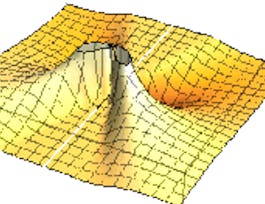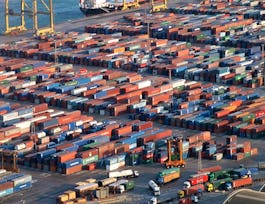Course 4 of Statistical Thermodynamics addresses dense gases, liquids, and solids. As the density of a gas is increased, intermolecular forces begin to affect behavior. For small departures from ideal gas behavior, known as the dense gas limit, one can estimate the change in properties using the concept of a configuration integral, a modification to the partition function. This leads to the development of equations of state that are expansions in density from the ideal gas limit. Inter molecular potential energy functions are introduced and it is explored how they impact P-V-T behavior. As the density is increased, there is a transition to the liquid state. We explore whether this transition is smooth or abrupt by examining the stability of a thermodynamic system to small perturbations. We then present a brief discussion regarding the determination of the thermodynamic properties of liquids using concept of the radial distribution function (RDF), and how the function relates to thermodynamic properties. Finally, we explore two simple models of crystalline solids.


Dense Gases, Liquids and Solids
This course is part of Statistical Thermodynamics Specialization
Taught in English
Some content may not be translated

Instructor: John W. Daily
5,226 already enrolled
Included with 
Course
(112 reviews)
What you'll learn
Analyze the impact of intermolecular forces on the transition of gases to liquids as density increases
Evaluate the stability of a thermodynamic system as it transitions from gas to liquid state in response to small perturbations
Assess the role of the radial distribution function (RDF) in determining thermodynamic properties of liquids
Describe the behavior of crystalline solids using simple statistical thermodynamics
Skills you'll gain
Details to know

Add to your LinkedIn profile
4 quizzes
Course
(112 reviews)
See how employees at top companies are mastering in-demand skills

Build your subject-matter expertise
- Learn new concepts from industry experts
- Gain a foundational understanding of a subject or tool
- Develop job-relevant skills with hands-on projects
- Earn a shareable career certificate


Earn a career certificate
Add this credential to your LinkedIn profile, resume, or CV
Share it on social media and in your performance review

There are 4 modules in this course
As the density of a gas is increased, intermolecular forces begin to affect behavior. For small departures from ideal gas behavior, known as the dense gas limit, one can estimate the change in properties using the concept of a configuration integral, a modification to the partition function. This leads to the development of equations of state that are expansions in density from the ideal gas limit. Inter molecular potential energy functions are introduced and it is explored how they impact P-V-T behavior.
What's included
4 videos4 readings2 discussion prompts
As the density is increased, there is a transition to the liquid state. We explore whether this transition is smooth or abrupt by examining the stability of a thermodynamic system to small perturbations. We also explore Gibb's phase rule.
What's included
3 videos3 readings1 quiz1 discussion prompt
In this Module we present a brief discussion regarding the determination of the thermodynamic properties of liquids using the concept of the radial distribution function (RDF), and how the function relates to thermodynamic properties. This includes introducing the use of molecular dynamics to obtain the radial distribution function.
What's included
3 videos3 readings1 discussion prompt
It turns out that we can use the results of simple statistical thermodynamics to describe the behavior of crystalline solids.
What's included
2 videos2 readings3 quizzes
Instructor

Offered by
Recommended if you're interested in Mechanical Engineering

University of Colorado Boulder

University of Colorado Boulder

Coursera Project Network

University of Colorado Boulder
Why people choose Coursera for their career




Learner reviews
Showing 3 of 112
112 reviews
- 5 stars
70.53%
- 4 stars
16.07%
- 3 stars
7.14%
- 2 stars
1.78%
- 1 star
4.46%

Open new doors with Coursera Plus
Unlimited access to 7,000+ world-class courses, hands-on projects, and job-ready certificate programs - all included in your subscription
Advance your career with an online degree
Earn a degree from world-class universities - 100% online
Join over 3,400 global companies that choose Coursera for Business
Upskill your employees to excel in the digital economy
Frequently asked questions
Access to lectures and assignments depends on your type of enrollment. If you take a course in audit mode, you will be able to see most course materials for free. To access graded assignments and to earn a Certificate, you will need to purchase the Certificate experience, during or after your audit. If you don't see the audit option:
The course may not offer an audit option. You can try a Free Trial instead, or apply for Financial Aid.
The course may offer 'Full Course, No Certificate' instead. This option lets you see all course materials, submit required assessments, and get a final grade. This also means that you will not be able to purchase a Certificate experience.
When you enroll in the course, you get access to all of the courses in the Specialization, and you earn a certificate when you complete the work. Your electronic Certificate will be added to your Accomplishments page - from there, you can print your Certificate or add it to your LinkedIn profile. If you only want to read and view the course content, you can audit the course for free.
If you subscribed, you get a 7-day free trial during which you can cancel at no penalty. After that, we don’t give refunds, but you can cancel your subscription at any time. See our full refund policy.

